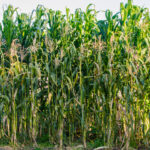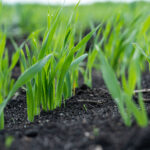Grow full, sweet ears by getting spacing, depth, and layout just right.
After many seasons growing sweet corn in home garden beds and raised plots, I’ve found that getting spacing, planting depth, and block layout right from the start is essential for a reliable harvest. Sweet corn relies on wind for pollination, so how—and where—you plant makes all the difference.
Planting Sweet Corn: Depth and Spacing for Success
Start by sowing pathogen-free sweet corn seeds when the soil temperature reaches at least 60°F (16°C)—warmer is even better. I typically sow seeds about 1 to 1½ inches deep, but in hot mid-summer weather, I’ve had better germination sowing seeds a bit deeper—3 to 4 inches deep—to reach cooler soil moisture.
Spacing matters when it comes to strong stalks and full ears:
- Set seeds about 2 to 4 inches apart in rows.
- Space rows about 30 to 36 inches apart for good airflow and sunlight.
- Thin seedlings once they reach 4 to 6 inches tall:
- Short varieties: space to 12 to 18 inches apart
- Tall varieties: space to 18 to 24 inches apart
Tighter spacing can lead to smaller ears and higher demand for water and nutrients, especially in summer heat. I’ve noticed that crowded corn often yields shorter, thinner stalks and fewer plump ears.

Why Block Planting Beats Long Rows
Corn is wind-pollinated, which means that pollen from the tassels at the top of the plant must fall or blow onto the silks lower on the stalk. Each silk corresponds to a single kernel. If a silk isn’t pollinated, the kernel won’t develop.
That’s why block planting—forming a square patch of corn—is more effective than long, single rows. When corn is planted in blocks of 4 to 6 short, side-by-side rows, wind can more easily move pollen between plants, improving pollination and boosting your yield.
Here’s what’s worked for me:
- Create a corn patch at least 4 feet by 4 feet
- Space plants 6 to 8 inches apart, with rows 18 to 24 inches apart
- If space is tight, grow corn in hills or mounds, planting 3 to 4 seeds per hill, and space hills about 3 feet apart
Even in raised beds or smaller gardens, this approach has consistently given me fuller ears with fewer pollination gaps.
Soil Prep: Building a Nutrient-Rich Foundation
Corn is a heavy feeder, so healthy soil is key. I recommend:
- Turning soil to at least 6 inches deep
- Incorporating plenty of aged compost for moisture retention and slow-release nutrients
- Adding a nitrogen-rich fertilizer, such as cottonseed meal or soybean meal, at about 3 pounds per 100 square feet
If your corn leaves turn pale or growth seems slow, side-dressing with compost or organic fertilizer can help.
Pollination Tips: Let the Wind—and You—Do the Work
Once tassels appear, keep an eye out for the silks emerging on the ears. To support pollination:
- Gently shake each stalk daily when tassels are shedding pollen. This mimics wind and ensures silks catch the pollen.
- Avoid overhead watering during this stage, as it can wash pollen away.
In calm or enclosed gardens, this extra step can significantly increase your number of full ears.
Avoiding Cross-Pollination
Different varieties of corn—especially sweet, field, and popcorn—can cross-pollinate, which may impact flavor and texture. I’ve learned to:
- Separate different corn types by at least 100 feet, or
- Stagger planting times by two weeks, so one variety finishes pollinating before the next starts tasseling
This ensures that each variety retains its unique taste and quality.
Tips for Continuous Harvests
For fresh corn all summer long:
- Succession plant every 2 to 3 weeks, or
- Plant early, midseason, and late-maturing varieties at the same time—they’ll mature in sequence for a rolling harvest
And don’t toss leftover seeds! Sweet corn seed remains viable for 1 to 3 years if stored in a cool, dry, airtight container.
Overview Post: How to Grow Corn: The Complete from Planting to Harvest
🌽 Related Posts: Explore More on Growing Corn
🌱 Getting Started with Corn
- Starting Sweet Corn from Seed: Proven Tips for Early Success
- When and Where to Plant Sweet Corn for the Best Yield
- Planting Sweet Corn: Spacing, Block Planting, and Depth Tips
- Can You Grow Corn in Containers? Yes-Here’s How
💧 Watering, Feeding, Pollination & Care
- How to Water and Fertilize Sweet Corn for Maximum Yield
- Sweet Corn Pollination: Natural and Hand-Pollination Tips
- The Best Companion Plants for Sweet Corn (And What to Avoid)
- What To Do When Corn Falls Over (Lodging Tips)
🌽 Harvest, Storage & Serving
- How to Harvest and Store Sweet Corn
- How to Store Fresh Corn and Preserve It for Later
- Seven Easy Wasy to Cook and Serve Sweet Corn
🐛 Pests, Diseases & Troubleshooting
🌟 Sweet Corn Varieties



